Key takeaways:
- Data cleaning is essential for accurate analysis and builds trust with stakeholders, as it addresses inaccuracies that can skew results.
- Common techniques include handling missing values through imputation, identifying outliers with methods like Z-scores, and normalizing data for consistency.
- Challenges in data cleaning involve dealing with missing values, inconsistent formats, and human errors, requiring a mix of automated checks and manual review.
- A systematic approach, including workflow establishment, data backups, and team communication, enhances the effectiveness of the data cleaning process.
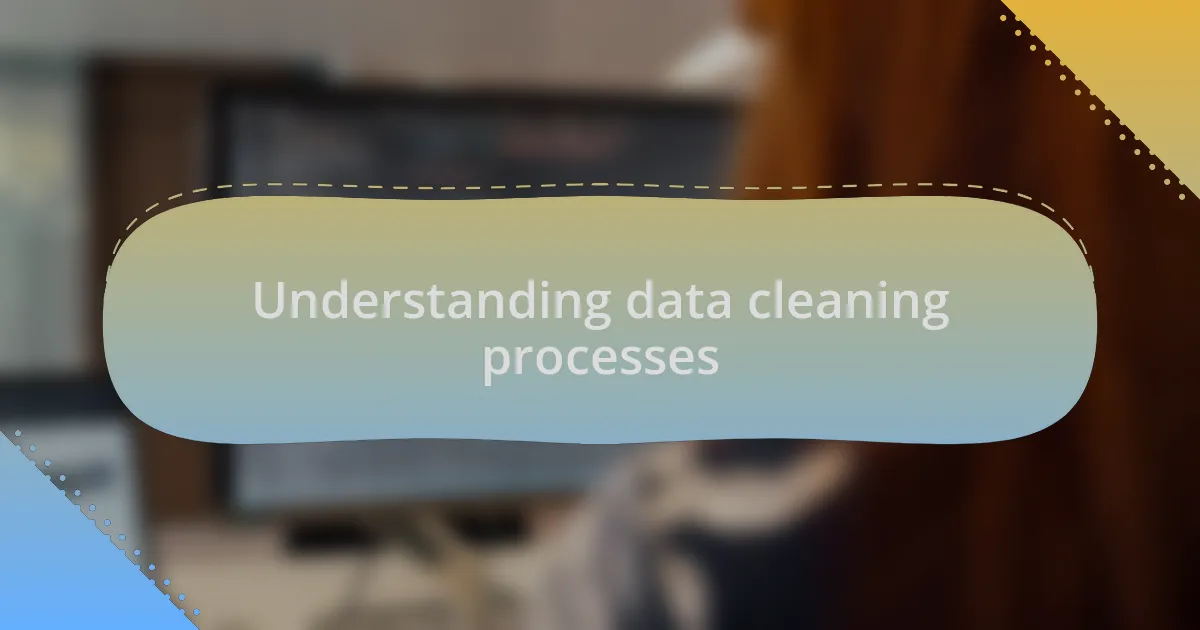
Understanding data cleaning processes
Data cleaning is the unsung hero of data analysis, often overlooked but crucial for reliable results. I remember my first big data project; I was excited to dive into analytics but was met with a mountain of messy data. It hit me hard when I realized that without cleaning, my insights would be shaky at best—how could I trust conclusions built on errors and inconsistencies?
When I think about the data cleaning process, it feels like a rite of passage for anyone in the field. You meticulously examine datasets, identifying duplicates, handling missing values, and correcting outliers. Each task requires not just technical skills but also a keen eye for detail. Have you ever experienced the thrill of turning chaos into clarity? There’s a profound satisfaction in transforming flawed data into a clean, organized format ready for insightful analysis.
It’s fascinating how data cleaning not only enhances data quality but also fosters deeper understanding. By addressing inaccuracies, you’re not just fixing problems; you’re unlocking potential. I often find that the time spent on cleaning pays dividends later on, as it leads to more trustworthy outcomes. Could it be that this foundational work is what truly elevates your analytical prowess?
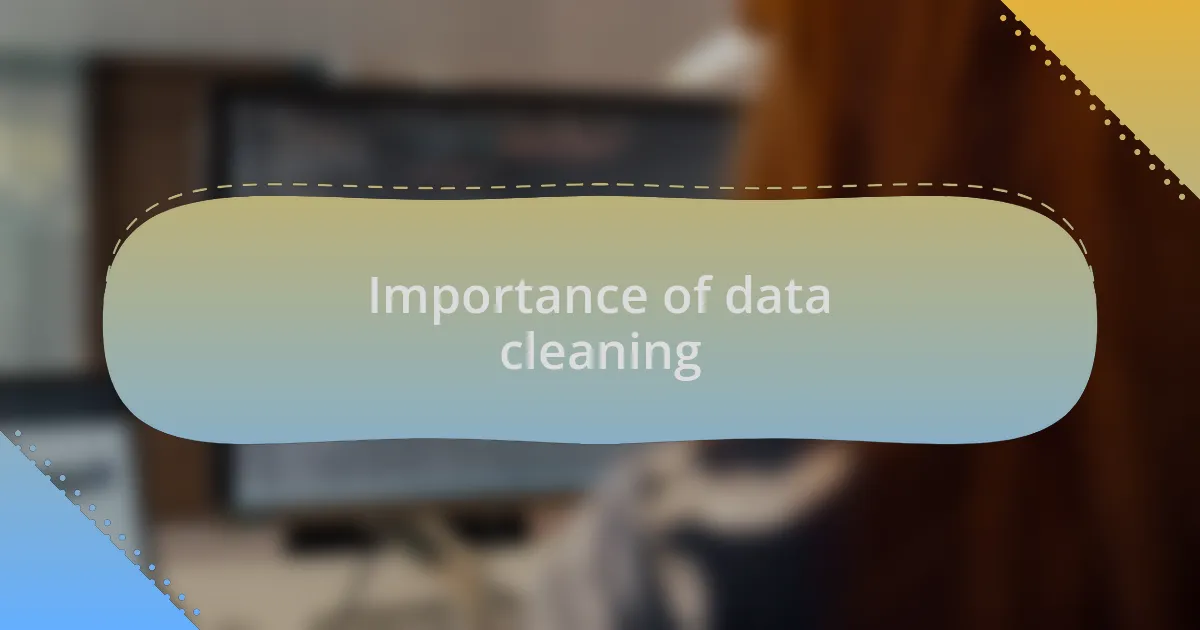
Importance of data cleaning
Data cleaning is crucial because it directly impacts the accuracy of analysis. I recall a project where I overlooked a few missing values, thinking they were negligible. When I received the final results, they were so skewed that I questioned everything I had learned about data relevance. Isn’t it fascinating how a seemingly small detail can lead to such a chaotic outcome?
Moreover, the importance of data cleaning extends beyond just improved accuracy; it builds trust with stakeholders. There was a point in my career when I presented findings based on unclean data to a client. Their skepticism was palpable, and I realized that without a solid foundation, my credibility was on the line. Isn’t it vital that our findings can stand up to scrutiny?
Ultimately, investing time in the data cleaning process ensures that we harness the true power of our datasets. I’ve learned that this effort is not merely a technical task; it’s a commitment to delivering insightful, actionable intelligence. Have you ever thought about how much more confident you could feel presenting your results with a clean dataset backing them up?
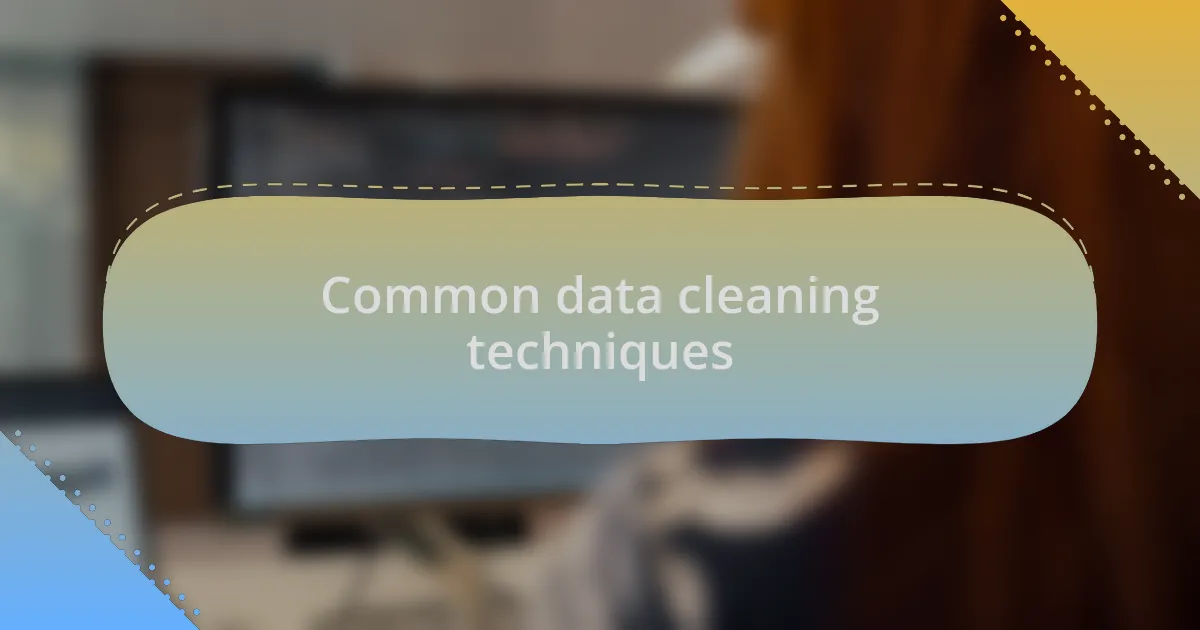
Common data cleaning techniques
When it comes to common data cleaning techniques, dealing with missing values is often the first step. In one of my early projects, I encountered a dataset with significant gaps that I initially tried to ignore. As I delved deeper, I recognized the power of imputation methods—replacing missing values with estimates based on other data points. Did you know that simply filling gaps can transform the usability of your data? It’s fascinating how a structured approach can turn a frustrating situation into an opportunity for deeper insights.
Another technique that deserves attention is outlier detection. I once faced a scenario where a single outlier skewed my entire analysis, leading me to erroneous conclusions. I learned to implement techniques like the Z-score or the IQR method to identify these anomalies, which helped me maintain the integrity of my analysis. Have you ever spotted an outlier that turned out to be a game-changer in your results? Recognizing and understanding outliers can illuminate critical trends and ensure that your conclusions are grounded in reality.
Lastly, data normalization is a technique I often leverage to harmonize different data scales. Early on, I had a dataset with various scales that made comparisons feel like apples to oranges. By normalizing the data, I could easily draw insights across diverse metrics. It’s like leveling the playing field; isn’t it amazing how consistency can elevate your analysis? These techniques don’t just enhance data quality—they empower us to tell a clearer story with the information at hand.
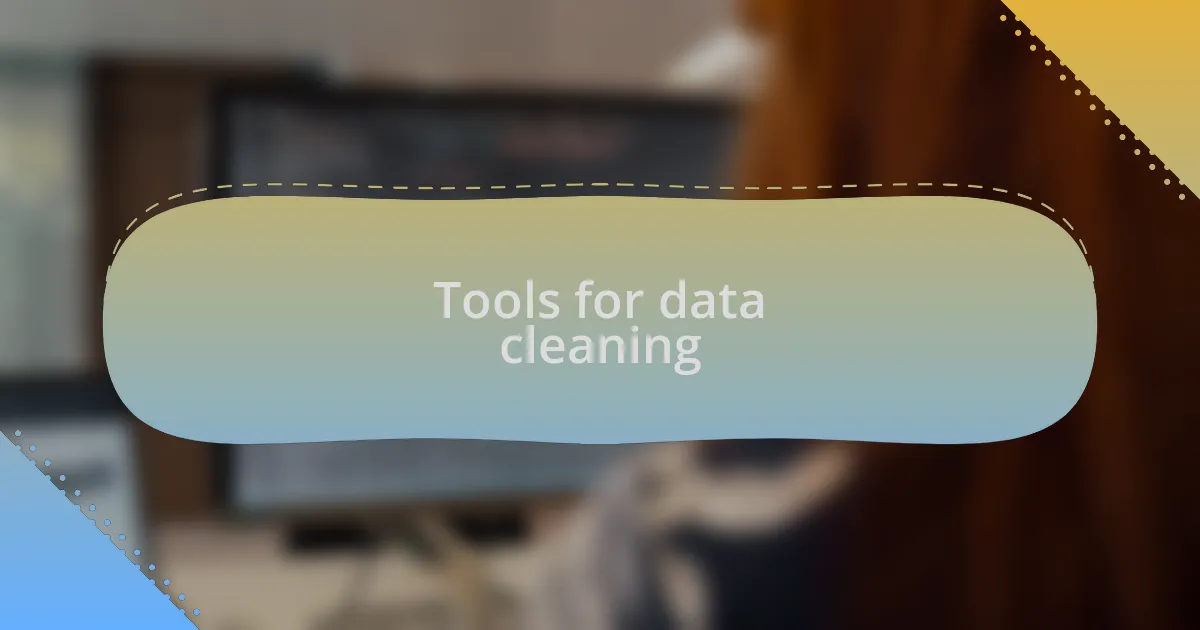
Tools for data cleaning
When it comes to tools for data cleaning, I’ve found that software like OpenRefine is invaluable. In a project that had messy, inconsistent data entries, it was a game changer. I recall sifting through countless rows of data, and OpenRefine’s ability to cluster similar values made it feel almost magical as I watched duplicates merge seamlessly into single entries. Have you ever experienced that moment of clarity when a complicated problem suddenly gets easier?
Python libraries such as Pandas and NumPy have also transformed my approach. I remember learning to use these tools for the first time and feeling a mix of excitement and intimidation. However, once I grasped the power of DataFrames and the simplicity of function calls, I quickly realized how efficiently I could handle tasks like filtering and transforming data. Have you ever been amazed at how a few lines of code can save you hours of manual work?
For more visual learners, ETL (Extract, Transform, Load) tools like Talend can be a fantastic asset. I once used Talend for a project involving multiple data sources, and it streamlined the entire cleaning process. I loved watching the data flow from one stage to another seamlessly, which turned a chaotic process into an organized workflow. Isn’t it fascinating how the right tool can completely shift your perspective on data handling? Finding the right tool can empower you to focus on analysis rather than getting bogged down in cleaning.
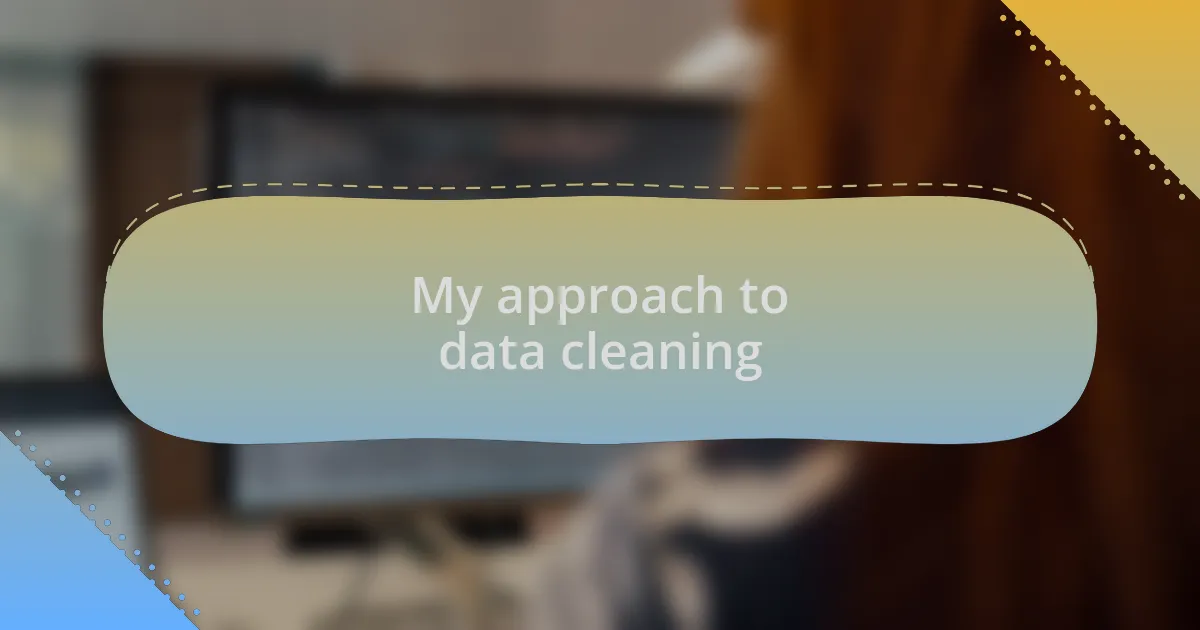
My approach to data cleaning
When it comes to my approach to data cleaning, I prioritize understanding the data before diving into the cleaning process. Each dataset tells a story, and I remember a particular instance when I spent time analyzing a dataset’s structure, uncovering patterns I hadn’t expected. Have you ever noticed how essential context can change your perspective on why certain entries are inaccurate or missing?
I also believe in the importance of iteration. My first pass at cleaning is rarely perfect. There’s often a moment of frustration when I think I’ve fixed all the issues, only to discover new ones upon closer inspection. It’s a reminder that cleaning data is a journey, not a destination. Does that resonate with you?
One of the most effective strategies I’ve adopted is to document my cleaning process meticulously. In a recent project, I created a simple log of all the changes I made, which not only helped me track my decisions but also proved invaluable when revisiting the dataset weeks later. Have you ever wished you could remember the thought process behind your previous fixes? Keeping a record helps me reclaim that clarity and ensures I can explain my choices to others if needed.
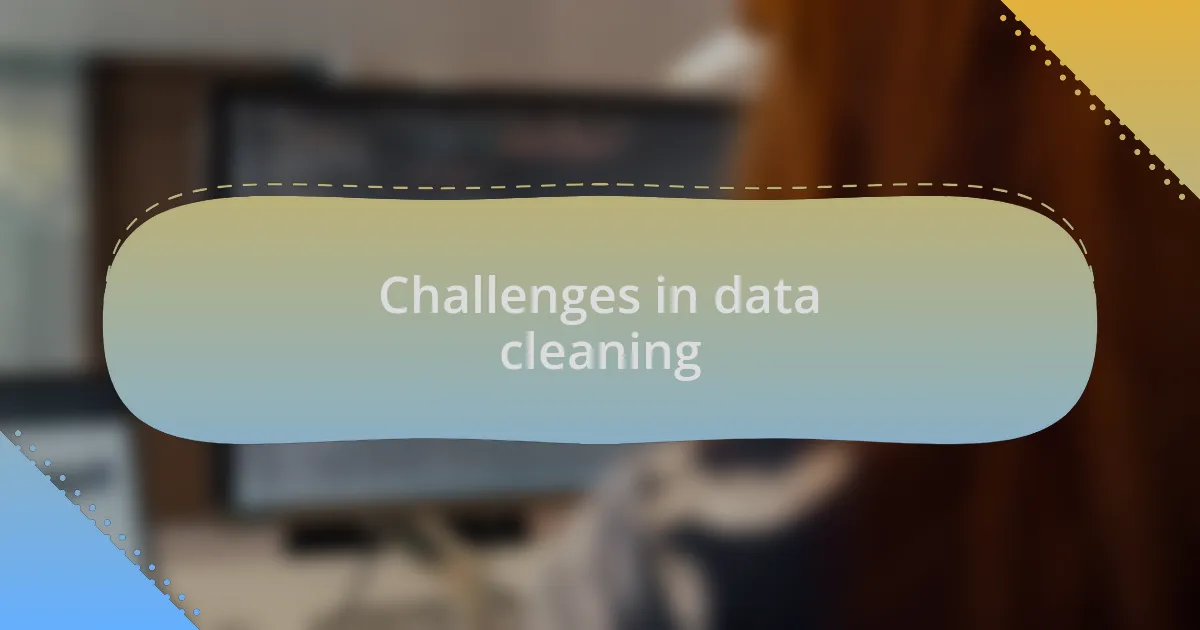
Challenges in data cleaning
Data cleaning presents a variety of challenges that can be quite daunting. One major issue I often face is dealing with missing values. In one project, I encountered a dataset where nearly 30% of the entries were missing crucial information. This raised questions for me: Should I fill in those gaps, or should I leave them as they are? It’s a tricky balance, and the choices made here significantly impact the dataset’s integrity.
Another challenge is managing inconsistent data formats. I remember a time when I worked with a dataset that included dates formatted in multiple ways. Some were in MM/DD/YYYY, while others were in DD/MM/YYYY. This inconsistency not only caused confusion but also led to errors in analysis. Have you ever spent hours trying to standardize data only to find more discrepancies? It’s an exhausting but necessary part of ensuring reliability in analysis.
Lastly, I can’t overlook the human element involved in data cleaning. Often, the inconsistencies stem from user input errors, which can be quite frustrating. I recall sifting through entries that had misspellings or incorrect classifications that couldn’t have been caught through automated processes alone. It’s a reminder that while technology is powerful, it’s not infallible. How do you manage such errors in your data cleaning process? Finding a solution often requires a mix of automated checks and a keen eye for detail.

Tips for effective data cleaning
One of the key tips for effective data cleaning is to create a systematic approach by establishing a clear workflow. From my experience, a structured process helps in identifying issues more efficiently. For instance, I typically start with an initial audit of the data. This first step often reveals hidden problems that might otherwise be overlooked. Have you ever jumped straight into cleaning only to realize later that a fundamental flaw existed? Taking the time to assess the dataset at the outset can save countless hours in the long run.
Another essential practice is to keep backups of the original data before making any changes. I learned this the hard way when I inadvertently deleted important information while cleaning. I can’t express how relieving it was to have a backup to revert to, which not only salvaged my project but also gave me peace of mind. How often do we think we won’t need the ‘messy’ data again? It’s a common pitfall, but trust me, a backup is your safety net in this uncertain landscape.
Lastly, I advocate for consistent communication with team members throughout the data cleaning process. Collaboration can bring new perspectives, making it easier to spot errors or inconsistencies that one might miss alone. I vividly remember a project where my colleague pointed out a misleading entry that had slipped past my analysis. That moment underscored the value of teamwork—how do you engage your team when tackling what can feel like an isolating task? Building that rapport makes the journey much more manageable and even enjoyable.